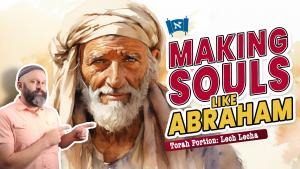An Eye For An Eye
Series:
I was recently asked a sincere question about the relationship of Yeshua to the Torah. Yeshua’s words in Matthew 5 seem to advocate changing the Torah’s principle of “eye for eye” with grace and mercy. The question was as follows:
God gave the people laws to obey, as recorded in Exodus 21 ("these are the laws you are to set before them..." v. 1) through 23. Among them is "an eye for an eye, tooth for tooth" (v. 24). Yeshua said "you have heard they were told 'an eye for an eye, a tooth for a tooth.' But what I tell you is this: do not resist those who wrong you..." (Mt. 5:38-42). If we are required to be fully Torah observant, and Yeshua was simply establishing a way for us to do so in practice but without making any actual change to the laws Moses communicated, then how could Yeshua establish a new law of mercy in their place as he told his followers here?
Maybe you have come across this type of question as well. In our current newsletter, I address this question with an article entitled “An Eye For An Eye,” explaining Yeshua’s teaching in this instance. Maybe it will help you to explain this seeming contradiction to others who have posed this or a similar question to you. When men strive together and hit a pregnant woman, so that her children come out, but there is no harm, the one who hit her shall surely be fined, as the woman's husband shall impose on him, and he shall pay as the judges determine. But if there is harm, then you shall pay life for life, eye for eye, tooth for tooth, hand for hand, foot for foot, burn for burn, wound for wound, stripe for stripe. (Exodus 21:22–25)
An Eye For An Eye
Upon a cursory read of the books of Moses, the Torah, some of the laws contained within it not only seem a bit harsh, but even barbaric at times. Leviticus 24:19–20 says, “If anyone injures his neighbor, as he has done it shall be done to him, fracture for fracture, eye for eye, tooth for tooth; whatever injury he has given a person shall be given to him.” So, it would seem that from this command and the one in Exodus 21, that the Torah condones a retaliatory style of justice. If two people get in a fight and one gouges out the other’s eye, then the offender is to be held down and have his eye gouged out as payment for the offense. Yeshua seems to come and soften the Torah’s extreme system of justice when he says,
You have heard that it was said, ‘An eye for an eye and a tooth for a tooth.’ But I say to you, Do not resist the one who is evil. But if anyone slaps you on the right cheek, turn to him the other also. And if anyone would sue you and take your tunic, let him have your cloak as well. And if anyone forces you to go one mile, go with him two miles. Give to the one who begs from you, and do not refuse the one who would borrow from you. (Matt 5:38-42)
From this passage, it appears that Yeshua is telling his disciples that the Torah prescribed one, strict method of dealing with damages and injuries and he is prescribing another, more lenient method. Where the Torah endorsed strict, retaliatory justice, Yeshua endorses mercy and grace.
But is this really what’s going on here? We must ask ourselves two questions in this regard. First, was the Torah’s system of justice — the commandments audibly given by God Himself on Mount Sinai — an unjust system, or one of merely strict justice without mercy? Second, would Yeshua ever teach opposition to the commandments of the Torah, the instructions given by his Heavenly Father? Was his teachings coming from a different source than the Judaism practiced by Moses, David, Solomon, Isaiah, Jeremiah or any of the prophets? Was he as far removed from the ethical standard of Torah-based rabbinic Judaism as Christianity tends to imagine?
In order to answer these questions, we must first see how Judaism contemporary to Yeshua and the early believers understood the Torah’s “eye for an eye” commandments in order that we don’t superimpose an explanation on the text it was never understood to have.
The Talmud, Judaism’s most sacred text outside of the Bible itself, deals with this seemingly harsh treatment of justice candidly:
Does the Divine Law not say ‘Eye for eye’? Why not take this literally to mean [putting out] the eye [of the offender]? — Let not this enter your mind, since it has been taught: You might think that where he put out his eye, the offender's eye should be put out, or where he cut off his arm, the offender's arm should be cut off, or again where he broke his leg, the offender's leg should be broken. [Not so; for] it is laid down, ‘He that smiteth any man…’ ‘And he that smiteth a beast…’ just as in the case of smiting a beast compensation is to be paid, so also in the case of smiting a man compensation is to be paid. (b.Bava Kamma 83b)
Rashi, the preeminent Jewish commentator of the eleventh century, builds on this by saying:
'An eye in place of an eye' — If he blinded his fellow man's eye, he gives him the value of his eye, which is assessed in terms of how much his value has decreased by his blinding… And so, too, all of them, i.e., all the limbs and organs mentioned in this verse are similarly assessed. It does not mean the literal taking of a limb of the offender. (Rashi on Exodus 21:24)
These two texts make it clear that retaliatory justice was never imagined in the Torah or by the courts of justice which the Torah established by way of the Sanhedrin. We have no record of these passages ever being taken literally and justice being dealt in such a brutal manner as most of Christianity suggests of Judaism. Rather than literally gouging out the eye of an offender, the courts would evaluate the value of the eye of the victim and order compensation for the amount determined. As a matter of fact, the Bible, itself, bears this out. In the verses which precedes our primary text, we read:
When men quarrel and one strikes the other with a stone or with his fist and the man does not die but takes to his bed, then if the man rises again and walks outdoors with his staff, he who struck him shall be clear; only he shall pay for the loss of his time, and shall have him thoroughly healed. (Exodus 21:18–19)
And later on we read:
When an ox gores a man or a woman to death, the ox shall be stoned, and its flesh shall not be eaten, but the owner of the ox shall not be liable. But if the ox has been accustomed to gore in the past, and its owner has been warned but has not kept it in, and it kills a man or a woman, the ox shall be stoned, and its owner also shall be put to death. If a ransom is imposed on him, then he shall give for the redemption of his life whatever is imposed on him. If it gores a man's son or daughter, he shall be dealt with according to this same rule. If the ox gores a slave, male or female, the owner shall give to their master thirty shekels of silver, and the ox shall be stoned. (Exodus 21:28–32)
The Mishnah, the authoritative and definitive code of Jewish law, describes the criteria for determining the value of an “eye” or “tooth” or any other injury sustained by the victim:
He who injures his fellow is liable to [compensate] him on five counts: (1) injury, (2) pain, (3) medical costs, (4) loss of income [lit.: loss of time], and (5) indignity. (m.Bava Kamma 8:1)
One should not think, however, that the Torah never prescribes corporeal punishment. The Torah goes so far as to prescribe capital punishment for some violations. However, the Pharisaic view of the Torah’s justice would prefer capital punishment to be an extremely rare event. They said believed a court of the Sanhedrin that put one person to death in seventy years was to be considered “a bloody Sanhedrin” (m.Makkot 1:10; b.Makkot 7a).
So, when Yeshua makes the statement, You have heard that it was said, “An eye for an eye and a tooth for a tooth,” what is he referring to? Is Yeshua over-riding the Torah? Not at all. As we have noted, the Torah makes provision for damages, via the “eye-for-an-eye” passages. These laws of damages served a two-fold purpose. First, they were for the protection of those who incur damages at the hands of others. Most importantly, however, they were for the person who was liable for the damages (the perpetrator), to teach one the lesson of taking personal responsibility for the harm of others. These laws were never created to create a system of demands from the one incurring damages (the victim). Nor were they ever never a means of retaliation for damages, but rather be compensated for damages. The Torah’s legislation addresses the perpetrator. It gives instruction as to how they should attempt to undo the damages they have caused by measuring out specific methods of repayment for specific damages, giving the court a basis of value by which it can issue decrees of compensation.
Yeshua, on the other hand, addresses the victim. He says, “Do not resist the one who is evil. But if anyone slaps you on the right cheek, turn to him the other also” (Matthew 5:39). By doing so, he specifically addresses the response of the victim, rather than the responsibility of the perpetrator (which has already been addressed in the Torah). He makes it clear that when we are wronged — when we incur damages — we are not to demand restitution. We are to live by the “spirit of the Law.” The term “spirit of the Law” is a term that means one is at least doing the literal, letter of the Law, but then going beyond the minimum and doing even more than what the Law requires.
The spirit of the Law has, at the heart, a desire to treat others with the same mercy which we would desire to receive if the tables were reversed. This is what Yeshua was addressing. The Torah addresses the perpetrator, while Yeshua addresses the victim. Yeshua upholds Torah completely, and instructs us on how to live beyond the letter of the Law to the greater spirit of holiness which the Torah embodies.








